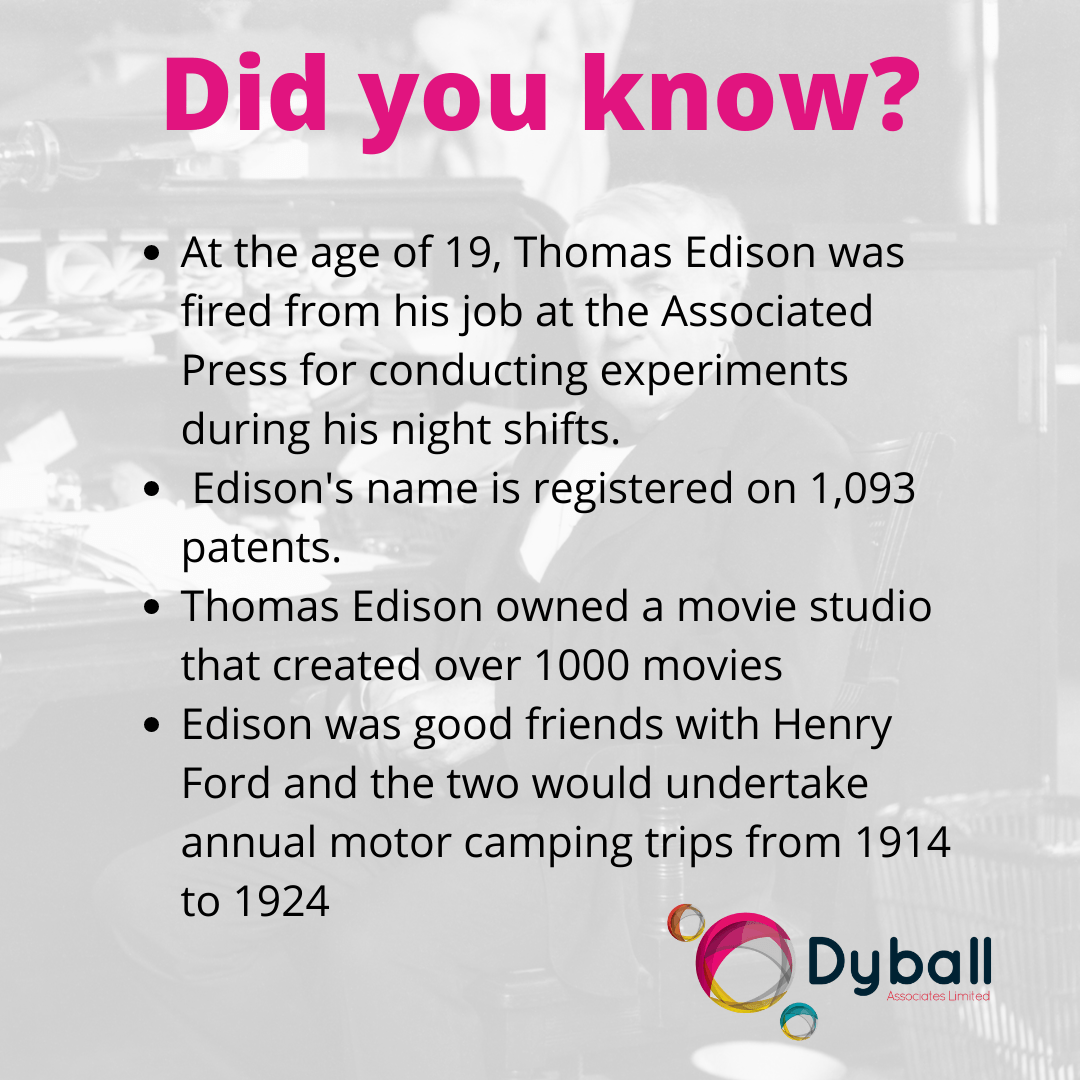Pioneers of Power : Thomas Edison
In part 5 of our Pioneers of Power series, we focus on Thomas Edison, the man who is often described as Americas greatest inventor.
Early Life
Thomas Alva Edison was born in 1847 in the town of Milan, Ohio and spent much of his youth growing up in the town of Port Huron in the state of Michigan. His parents were Samuel Ogden Edison Jr and Nancy Matthews Elliot and he was the youngest of seven children.
Thomas contracted Scarlett Fever at a young age and the disease is thought to have been the main factor in causing his deafness. Throughout his life, he would struggle with hearing difficulties but as he grew up, he would often come up with different stories as to how the impairment came to be.
As seems to be the way with many of these pioneers of science and technology, Thomas spent very little time at school and was instead mostly home-schooled by his mother. He was an avid reader and devoured many books written by the scientific minds of the day.
As a boy, Thomas got a job selling newspapers and sweets on the trains that ran from Port Huron to Detroit and sold vegetables. It was during his time working on the trains that he saved the life of a toddler called Jimmie MacKenzie by pushing him out of the path of an approaching runaway train. As a sign of gratitude by the boy’s father Thomas was given the job of telegraph operator.
He often frustrated the teachers at the schools he did attend, instead of focusing on his studies and purchasing of electric and chemical sets that he would use to conduct experiments.
Following his stint on the railways, Thomas turned to the newspaper industry and with the help of a few assistants launched the Grand Trunk Herald as well as other newspapers. It was during this time in the print business that Thomas discovered his talent for business and throughout his life, he would found 14 businesses including General Electric, which remains to this day one of the largest publicly traded businesses on the planet.
Edison and Electricity
Edison invented thousands of things including the motion picture camera and the phonograph but the most famous of all his inventions is the incandescent light bulb.
In 1878, Thomas was focused on creating a new way to illuminate towns and cities. His fascination and knowledge with electricity made it a natural focus point and so he founded the Edison Electric Light
Company and began work on creating a long-lasting incandescent lamp.
The Edison Electric Light Company was backed by the famous financiers J.P. Morgan and Spencer Trask.
Before the invention of the light bulb, illumination was provided by natural gas or oil lamps. Other inventors had dabbled with electric illumination in the past, but it would be Edison who created an electric light source that worked.
The first successful test was carried out on October 22, 1879, when a carbon filament bulb lasted 13.5 hours. After this successful test Edison said: “We will make electricity so cheap that only the rich will burn candles.”
Attending the demonstration was the president of the Oregon Railroad and Navigation Company Henry Villard. He was so impressed with the bulb that he asked Edison to install his electric lighting system aboard his new steamship the Columbia. It was the first commercial application for the electric light bulb.
From this success, Thomas would continuously refine and improve the bulb’s design. His patent for an electric lamp using a carbon filament was approved in January 1880.
Edison and Electricity Distribution
It was while developing the incandescent light bulb that Edison turned his attention to creating an electric system that would provide electricity to homes and businesses from a central point.
In 1882 he developed the USA’s first central electric power station and system which went on to provide electricity to 85 customers in Manhattan. Within 20 years of this invention, there were over 3,500 different electric systems in use across the USA.
To further his new electric system, Edison founded the Edison Illuminating Company and patented a system for electricity distribution. In 1882 he went to London and switched on the first steam-generating power station at Holburn Viaduct.
Edison’s DC supply system was adopted across the world, but its dominance was soon to be tested in the form of the Alternative Current (AC) system.
The War of the Currents
The clash between the two systems began in the late 1880s and 1890s when George Westinghouse’s company began to challenge Edison’s company. The former used the AC system and introduced transformers that reduced the voltage for it to be used for indoor lighting.
The AC system had several advantages over DC with the biggest one being the higher voltage allowing power to be transmitted over longer distances. To counter the AC threat, Edison began a campaign against it that accused AC of being hazardous and that the design of Westinghouse’s systems was flawed.
Critics of the AC system tried to prove that it was more dangerous than DC by publicly killing animals with both currents with assistance from Edison Electric. They continued to collude to limit the use of AC by ensuring that the first-ever electric chair was powered by an AC generator.
Edison’s opposition to AC was not going down well with his investors and by the 1890s his company was bringing in far less money than his opponents.
The clash began to wind down in the early 1890s as the legitimate flaws in the AC system were fixed and the system improved upon. Business mergers also saw Edison Electric be joined with General Electric one of Thomas’s biggest AC rivals. The merger meant that the company controlled over three-quarters of the US electrical market.
Later life
Thomas Edison will always be remembered for being one of the worlds greatest ever inventors and pioneers of electricity.
Edison kept working right up until his death from complications of diabetes on October 18, 1931.
His numerous inventions laid the groundwork for many things that we take for granted today including the rechargeable battery and motion picture cameras. His interests took him into all sorts of fields such as mining and during World War One the pharmaceutical sector. He was a man who’s vision truly changed the world.
Further Reading
Pioneers of Power – Nikola Tesla
Pioneers of Power – Michael Faraday
Pioneers of Power – Benjamin Franklin
Pioneers of Power – William Gilbert
Dyball Associates are proud to help new supply businesses successfully launch in the UK market.
Through our energy market consultancy services, and the software we’ve developed, we’re supporting new UK electricity and gas suppliers get set up and start supplying.
For more information on how to start and manage an energy company, get in touch with Dyball Associates today.





